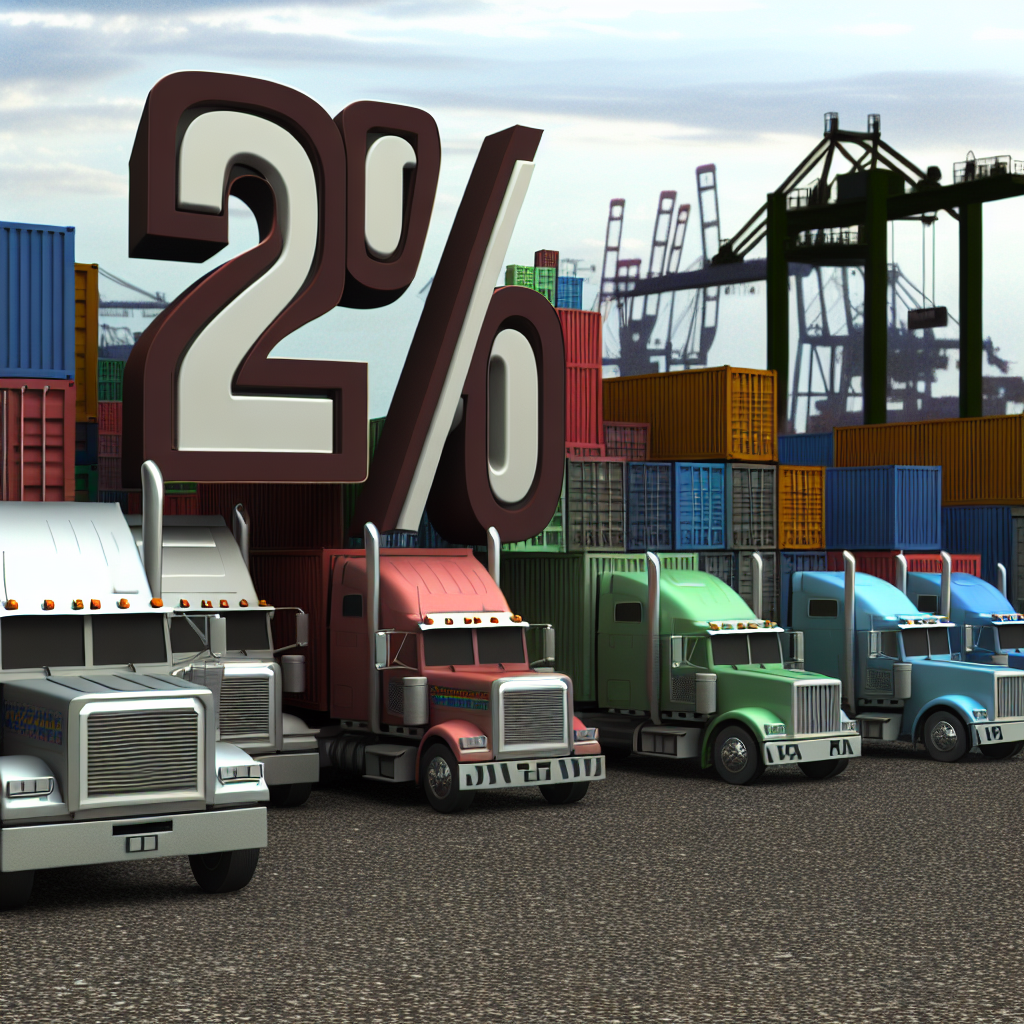As the global economy grapples with stagnation, various industries are feeling the effects, none more so than the heavy truck sector. Orders for heavy trucks, a barometer of the broader logistics and transportation industries, have faced significant challenges due to fluctuating economic conditions and shifting consumer demand. 2025 is shaping up to be particularly telling, with current projections indicating demand far below typical levels. Amid this uncertainty, manufacturers like Volvo Trucks are making strategic investments, preparing not just to weather the storm but to capitalize on the eventual market rebound.
Volvo Trucks, renowned for their innovation and robust product lineup, including flagship models like the VNL and VNR, are adapting to current conditions by focusing on future growth. Industry veterans like Magnus Koeck emphasize the importance of positioning and maintaining readiness for when demand inevitably rises again. This introduction sets the stage for an in-depth exploration of the current market dynamics, the responses of key players, and what the future may hold for heavy truck orders.
The heavy truck market in 2025 is facing tough challenges. North America is experiencing a sharp decline in demand and orders. The average order intake is now much lower than the historical five-year average of 285,000 units, which shows serious problems for manufacturers.
Industry leaders, including companies like Volvo and Daimler, are changing their strategies to handle these market difficulties. In semi-annual reports, heavy-duty truck sales in North America dropped by 25.6% year-over-year in September. This decline reflects broader economic struggles and consumer hesitation to make investments.
In contrast, the European market shows more stability. Steady demand there helps balance out the losses being seen in North America. Meanwhile, China is rapidly developing its heavy truck sector, with strong growth towards electric vehicles. This makes it a key market to observe for future opportunities.
This summary provides a clearer view of the current state of the heavy truck market, highlighting both opportunities and challenges faced by manufacturers.


Volvo Trucks’ Strategic Investments Amid Economic Stagnation
In the face of a stagnant economy and declining orders, Volvo Trucks is diligently investing in its future by focusing on innovative models and expanding production facilities. The company has recently unveiled enhancements to its flagship models, including the VNL, VNR, and the VNL Electric, reflecting a strong commitment to meet evolving market demands and environmental considerations.
Investment in New Models
The all-new Volvo VNL, launched in January 2024, incorporates various innovations such as optimized aerodynamics and cutting-edge technology, achieving up to a 10% improvement in fuel efficiency compared to its predecessor. This model is built on a flexible platform designed to accommodate an array of propulsion technologies, including battery-electric and renewable fuel variants, thus aligning with the industry’s shift towards sustainability.
Likewise, the Volvo VNR Electric has also seen significant upgrades, featuring a new six-battery configuration that increases energy storage up to 565 kWh. This enhancement allows for an operational range of up to 275 miles and supports rapid charging capabilities, facilitating smoother transitions for fleets aiming to adopt electric solutions. Such advancements ensure that Volvo Trucks is not only responding to current demands but also anticipating future needs as the market evolves.
Facility Upgrades and Future Capacity
Supporting these new models is the investment in manufacturing capabilities. The New River Valley Assembly Plant in Dublin, Virginia, recently underwent substantial upgrades to accommodate the production of the new VNL, with a significant $400 million investment aimed at fostering innovation and sustainability in manufacturing processes. This facility enhancement positions Volvo Trucks to be more competitive as the market begins its recovery.
Moreover, Volvo has announced plans for a new heavy-duty truck manufacturing plant in Monterrey, Mexico, set to commence operations in 2026. This facility will not only augment production capacity but also bolster Volvo’s strategic position in North America—an area crucial for future growth.
Expanding Electric Vehicle Infrastructure
To further support the integration of electric trucks, Volvo Trucks significantly scaled its Certified Electric Vehicle (EV) Dealer network, tripling the number of certified locations in North America. This initiative aims to provide customers with increased access to support and service for transitioning to battery-electric trucks, essential for facilitating industry-wide shifts towards electric vehicles.
Through these strategic investments, Volvo Trucks is establishing a robust foundation for future growth, demonstrating resilience amid current market conditions. As noted by company executives, the preparations being made today will position Volvo Trucks favorably once demand rebounds, allowing the company to meet the upcoming surge in freight requirements effectively. By maintaining a forward-looking approach, Volvo Trucks aims to lead the charge toward a more sustainable and efficient trucking industry.
| Year | Current Heavy Truck Orders | 5-Year Average Intake | Downturn Total |
|---|---|---|---|
| 2025 Demand | Unknown | 285,000 units | 212,000 units |
This table provides a clear visual comparison of the current heavy truck orders, the five-year average intake, and the average downturn total. The current order intake data reflects the anticipated challenges in the market, while the five-year average illustrates what has traditionally been expected in terms of demand.
Recent Consumer Sentiment in Truck Purchases
Recent analyses indicate a shift in consumer sentiment regarding truck purchases, characterized by increased caution and reluctance. This trend is influenced by economic factors, affordability concerns, and evolving market dynamics.
Consumer Sentiment and Buyer Reluctance
- A survey by the Dave Cantin Group revealed a 3% year-over-year decrease in consumer intent to purchase trucks and SUVs, with affordability cited as the primary reason.
- Inflation reaching a seven-month high has exacerbated these affordability issues, leading consumers to reconsider higher-priced vehicle purchases [source].
Additionally, the “peak truck” phenomenon suggests that while consumer interest in trucks remains, rising costs are pushing buyers toward more affordable alternatives, such as sedans [source].
Truck Purchase Trends
- The used truck market has seen significant activity, with a 37.2% increase in trucks listed for sale over the past year.
- Class 8 trucks experienced a 7.4% sales increase in March compared to the previous year.
- The average retail price for these trucks fell by 20.3%, from $75,407 to approximately $60,115, making them more accessible to buyers [source].
In the commercial vehicle sector, new vehicle sales increased by 14.2% year-over-year in 2024, indicating resilience despite economic uncertainties. However, the average days to turn (DTT) for new vehicles rose by 62.9% year-over-year, suggesting that while sales are up, vehicles are taking longer to sell [source].
In North Texas, demand for pickup trucks remains high, with a notable shift toward midsize trucks that offer a balance between city maneuverability and towing capacity. Advanced trims with enhanced technology and safety features are also gaining popularity [source].
Overall, while the truck market continues to show strength, consumer caution driven by economic factors and affordability concerns is influencing purchasing decisions, leading to shifts in both new and used truck sales trends.
Magnus Koeck has noted the prevailing unease among buyers with statements like, “The customers are reluctant now to buy trucks, and we will probably see that for some more time.” This caution underlines the current sentiment that buyers are waiting for more favorable conditions before making significant investments in truck purchases.
By mid-December, Koeck anticipates a clearer outlook which may indicate whether this cautious sentiment is likely to persist or improve. As he stated, “The only thing we know is the tide will turn,” indicating hope for a rebound in consumer confidence and market activity.
Industry Forecasts for the Heavy Truck Market
The heavy truck market is positioned at a crossroads as it heads into 2025, facing numerous challenges and uncertainties while maintaining a cautious sense of optimism for recovery. Industry leaders, including Magnus Koeck from Volvo Trucks, underscore the significance of keeping an eye on emerging trends that may shape future demand.
Currently, the heavy truck orders are experiencing a notable decline, with North America projected to see deliveries drop to approximately 265,000 units, a sharp decrease from previous estimates of 300,000. This decline is largely attributed to the ongoing recession within the long-haul freight sector, which has led to fluctuating freight volumes and prices. As Koeck points out, many customers have grown hesitant to purchase new trucks given the current economic climate, resulting in delayed orders and customers opting to retain older vehicles. Reportedly, the average age of long-haul trucks is around 6.4 years, indicating a market where fleets are holding on to older models longer than usual.
Magnus Koeck emphasizes the necessity for manufacturers to prepare for the inevitable market turnaround, stating, “The only thing we know is the tide will turn.” This sentiment reflects an underlying belief that market conditions will improve, potentially around mid-2026, when some industry insiders anticipate a spike in demand as fleets gear up for forthcoming emissions regulations.
Furthermore, various economic factors such as tariffs and inflation are influencing purchasing decisions. The U.S. implementation of a 25% tariff on imported heavy-duty trucks, effective from November 2025, is expected to further complicate pricing structures and consumer sentiment. Despite these short-term challenges, the outlook for the long term remains positive, with the global heavy-duty truck market estimated to grow from approximately USD 210 billion in 2024 to USD 300 billion by 2033, benefiting from infrastructure investments and the ongoing shift towards electric vehicles.
In conclusion, while the immediate forecast appears tepid, the potential for recovery looms on the horizon. As industry leaders like Koeck expressed, “By mid-December, we will have a very good outlook for what next year is going to bring us.” This cautious optimism emphasizes the importance of adaptability and readiness for manufacturers in the heavy truck sector to seize the opportunities that will arise when market conditions improve.
This situation invites both trepidation and hope among consumers and manufacturers alike as they prepare for dynamic shifts in the truck market landscape.
In summary, the challenges facing the heavy truck market in 2025 have prompted cautious yet strategic responses by manufacturers, particularly by Volvo Trucks, which has made significant investments aimed at maintaining its competitive edge. These investments in innovative models and upgraded production capabilities reflect their resilience in the face of economic uncertainty.
As the heavy truck orders have seen a marked decline, Volvo’s proactive stance, showcased through enhancements to vehicles like the VNL and VNR, positions them favorably for a market rebound when conditions improve. Industry sentiments, echoed by leaders like Magnus Koeck, emphasize that while the current landscape is fraught with obstacles, the tide for heavy truck orders is expected to turn.
Thus, the groundwork laid today will enable robust responses to future opportunities, signaling hope and growth for the heavy truck sector.
SEO Content Review and Edits for Optimization
In this analysis of the blog post focused on Heavy Truck Orders, we’ll optimize for SEO by enhancing the use of the primary keyword and related terms while preserving the article’s natural flow.
Utilizing the main keyword effectively:
- The main keyword “Heavy Truck Orders” needs to be strategically placed in headers and throughout the content to improve search engine rankings.
- Suggested enhancements include using the keyword in the introduction, subheadings, and conclusion while ensuring it fits organically into the sentences.
Incorporating related keywords:
- Related keywords such as “stagnant economy,” “Volvo Trucks,” “freight demand,” and “long-haul trucks” should be integrated into content to enrich the context around the main keyword. These keywords can also be utilized as anchor texts for internal linking.
Content Modification Suggestions:
-
Introduction:
- Rephrase to include “Heavy Truck Orders” early on:
As the global economy grapples with stagnation, recent trends in heavy truck orders highlight the challenges facing the heavy truck sector, which includes manufacturers like Volvo Trucks strategically investing in innovation despite subdued demand.
- Rephrase to include “Heavy Truck Orders” early on:
-
Heavy Truck Market Conditions:
- Emphasizing “heavy truck orders” is crucial here.
The heavy truck orders in 2025 have significantly declined, as North America sees a marked decrease below the average intake of 285,000 units. The fluctuating heavy truck market has prompted manufacturers like Volvo Trucks to revise their strategies in response to ongoing economic challenges.
- Emphasizing “heavy truck orders” is crucial here.
-
Customer Sentiment Analysis:
- Incorporate phrases to include keywords like “buying heavy trucks” or “heavy truck purchases” to enhance relevance.
Recent analyses reveal a cautious shift in consumer sentiment regarding heavy truck purchases, influenced by economic factors and affordability challenges.
- Incorporate phrases to include keywords like “buying heavy trucks” or “heavy truck purchases” to enhance relevance.
-
Summarizing Industry Forecasts:
- Ensure that statistics about “heavy truck orders” are clearly defined, making it easy for search engines to index this information.
The heavy truck orders are projected to fall, with forecasts indicating a decrease to approximately 265,000 units in North America due to the enduring stagnation in the freight sector. This presents critical challenges for manufacturers needing to prepare for an eventual market rebound.
- Ensure that statistics about “heavy truck orders” are clearly defined, making it easy for search engines to index this information.
-
Conclusion:
- Reinforce key messages about “Heavy Truck Orders”.
In conclusion, while challenges persist, Volvo Trucks’ investments in innovative models and electric vehicle infrastructure signify a proactive response to the evolving landscape of heavy truck orders, positioning them for future growth when conditions improve.
- Reinforce key messages about “Heavy Truck Orders”.
Enhancing Internal Linking:
- Create links within the article that direct readers to related topics such as “freight demand trends” and the “economics of heavy truck manufacturing”. This helps improve SEO rankings and keeps readers engaged.
User Engagement Improvements:
- Optimize formatting by breaking up long paragraphs for better readability. Include bullet points for key data points, and utilize subheadings to enhance navigation throughout the post.
By applying these modifications, the article will not only improve its optimization for “Heavy Truck Orders” but also enhance overall engagement and user experience, ensuring that it resonates well with both readers and search engines.
Economic Impact on Freight Demand and Heavy Truck Orders
As the U.S. trucking industry faces the repercussions of a stagnant economy, freight demand has seen a sharp decline. Here are some recent statistics and insights:
- Freight Volumes: National truckload volumes have decreased by approximately 14% to 15% year-over-year, indicating a notable reduction in freight demand. Source
- Freight Rates: The industry has struggled with ten consecutive quarters of depressed truckload pricing due to prolonged low demand. Source
- Operational Costs: Tariffs, such as a 25% duty on Class 8 trucks from Canada, have increased new truck prices, posing challenges especially for smaller carriers. Source
Despite these challenges, around 80% of carriers remain optimistic about demand growth in the near future, indicating resilience in the industry. Source
Overall, understanding the dynamics of a stagnant economy and its influence on freight demand is pivotal for manufacturers contemplating heavy truck orders and investments for the future.
As we delve deeper into the current state of the heavy truck market, understanding the broader economic conditions becomes crucial. The stagnation affecting various sectors is reflected acutely in the heavy truck industry, where order volumes have dipped significantly. This backdrop explains the strategic choices being made by leading manufacturers such as Volvo Trucks, who are not merely standing by but are actively adapting to these pressing conditions. By focusing investments on advanced models and innovative technologies, these companies are positioning themselves for recovery when the market eventually turns. It is this interplay between current industry challenges and forward-looking strategies that frames our examination of the market conditions for heavy trucks in 2025.
Let us now explore the specific dynamics and statistics that characterize the heavy truck market at this moment.


